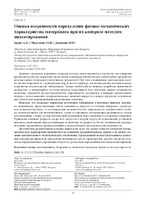| dc.contributor.author | Крень, А. П. | |
| dc.contributor.author | Мацулевич, О. В. | |
| dc.contributor.author | Делендик, М. Н. | |
| dc.coverage.spatial | Минск | ru |
| dc.date.accessioned | 2018-09-18T09:27:34Z | |
| dc.date.available | 2018-09-18T09:27:34Z | |
| dc.date.issued | 2018 | |
| dc.identifier.citation | Крень, А. П. Оценка погрешности определения физико-механических характеристик материалов при их контроле методом индентирования = Error estimation of the physical and mechanical characteristics measurements by indentation / А. П. Крень, О. В. Мацулевич, М. Н. Делендик // Приборы и методы измерений : научно-технический журнал. - 2018. – Т. 9, № 3. – С. 263-271. | ru |
| dc.identifier.uri | https://rep.bntu.by/handle/data/47618 | |
| dc.description.abstract | Активное внедрение в практику контроля методов индентирования, в частности для измерения физико-механических характеристик металлов, полимеров, биологических тканей требует разработки методик оценки погрешности получаемых результатов. При этом сложившаяся традиционная система оценки погрешности с применением мер не всегда пригодна для использования в испытательных и научно-исследовательских лабораториях. Целью данной работы являлась разработка применимой на практике и опирающейся на отечественную нормативную базу методики оценки погрешности косвенных измерений физико-механических характеристик материалов и проверка предлагаемого подхода с использованием экспериментальных значений твердости и модуля упругости, полученных при статическом индентировании для различных металлов. Показано, что поскольку первичным источником информации о материале является диаграмма вдавливания, представляющая собой зависимость нагрузки от глубины внедрения индентора в исследуемый материал, то подтверждение метрологических характеристик измерительной техники, использующейся для индентирования, лучше осуществлять по параметрам развиваемого усилия и перемещения, а точность определения свойств оценивать через погрешность косвенных измерений. Приведены основные формулы для расчета твердости и модуля упругости, позволяющие установить величины, наибольшим образом влияющие на величину погрешности. Расчет погрешности проведен на основе определяемых границ случайной и неисключенной систематической погрешности. Достоинством разработанной методики является тот факт, что оценка точности измерений физико-механических характеристик производится на основании экспериментальных данных и не требует создания дополнительного метрологического обеспечения. Предложенный подход представляется целесообразным распространить на определение погрешности других характеристик: предела текучести, показателя деформационного упрочнения, ползучести, релаксации, определяемых методами индентирования. | ru |
| dc.language.iso | ru | ru |
| dc.publisher | БНТУ | ru |
| dc.subject | Индентирование | ru |
| dc.subject | Погрешность | ru |
| dc.subject | Косвенные измерения | ru |
| dc.subject | Твердость | ru |
| dc.subject | Модуль упругости | ru |
| dc.subject | Indentation | ru |
| dc.subject | Measurement error | ru |
| dc.subject | Indirect measurement | ru |
| dc.subject | Hardness | ru |
| dc.subject | Elastic modulus | ru |
| dc.title | Оценка погрешности определения физико-механических характеристик материалов при их контроле методом индентирования | ru |
| dc.title.alternative | Error estimation of the physical and mechanical characteristics measurements by indentation | ru |
| dc.type | Article | ru |
| dc.identifier.doi | 10.21122/2220-9506-2018-9-3-263-271 | |
| local.description.annotation | The active application in the practice of testing the indentation methods, in particular to measure the physical and mechanical properties of metals, polymers, biological technologies demands to development techniques for the measurement error estimation. At the same time existing traditional measurement error evaluation system, based on the using of the reference blocks, is not always suitable for use in testing and research laboratories. The aim of this work was development the technique for estimating the indirect measurements error of materials physical and mechanical characteristics that can be applied in practice and based on the existing standards. Checking of the proposed approach using the experimental values of the hardness and elastic modulus obtained during static indentation for various metals. It is shown that since the initial information about the material is an indentation curve representing the dependence of the load versus penetration depth of the indenter into the material tested, then it is better to confirm the metrological characteristics of the indentation measuring devices using the applied force and achieved displacement, but to estimate the accuracy of determining the properties through the error of indirect measurements. The equations for calculating the hardness and modulus of elasticity are derived. It allows to determine the component value most influencing the error magnitude. The calculation of error on the base of the value of boundary of a random and non-exclusive systematic error was carrying out. The advantage of the developed technique is the fact that the measurement of the physical and mechanical characteristics is based on the experimental data and does not require the creation of the additional metrological assurance. The proposed approach seems appropriate to extend for the determination of the measurement error of other characteristics: the yield point, the strain hardening exponent, creep, relaxation, determined by the indentation methods. | ru |

